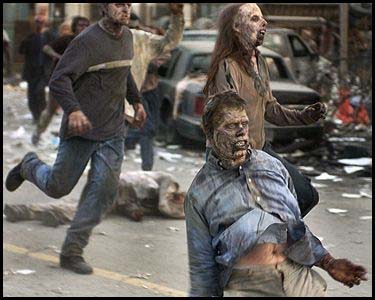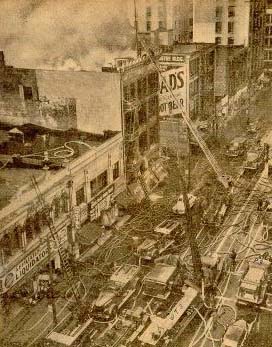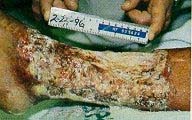

Famous Cases | Historical Tales | Vampires | Zombies
 |  |
Famous Cases | Historical Tales | Vampires | Zombies |
 |
| City Hall, Philadelphia |
During my years with the Vanguard in Los Angeles, we handled vampire suicide reports on a weekly basis. Vampires would fling themselves off buildings and in front of trains and trucks; they would light themselves on fire or take poison.
For those who still insist on treating vampirism as a romantic existence, consider the suicide note left behind by Jacob Drexel, member of a prominent Philadelphia family who was transformed in 1937. After Drexel leaped off the City Hall tower one snowy night, a suicide note was found that closed with the following lines: "I have been living in constant torment over the unspeakable acts I have committed, and yet I am powerless to stop committing them. May God forgive me."
Q: Many reports of cattle mutilations state that the blood has been drained and that certain organs have been removed. People have historically accused extraterrestrials of causing the mutilations, but is it more reasonable to assume that vampires are to blame?
![]() Nathan G., Eau Claire, Wisconsin
Nathan G., Eau Claire, Wisconsin
 |
| Mutilated cow New Mexico, 1989 |
In the absence of human prey, vampires will turn to animals for short-term sustenance. Favorite targets include cattle, sheep, dogs, cats and rodents. Although vampires cannot survive for long on animal blood, it will carry them through lean times until they can find more humans or go dormant. Interestingly, after vampires are done with an animal, other scavengers won't touch the carcass because the vampire scent remains long after the bloodsuckers have gone.
Recently, we have seen a spate of cattle mutilations in the American west, with increases noted from Montana to New Mexico. In June I will be traveling to the National Institute for Discovery Science in Las Vegas, Nevada, to examine some of the cattle remains. Apparently, a number of the cattle had puncture wounds, were drained of blood and were missing circulatory organs such as the spleen or liver or heart. Pathological examination will be necessary for a definitive diagnosis.
Though I have yet to conduct my examination, I believe most of these mutilations are the work of pranksters with too much time on their hands. But here in the southwest, the increase in mutilations, coupled with the disappearances of numerous illegal aliens, could point to a more sinister source. I will keep you posted.
For a copy of the FBI report on the cattle mutilations of the 1970s, go here.
 |
| My friend Baxter |
Of course, if you're unarmed and your preferred household pet is a cat, then you can improvise some fairly effective weapons out of household items when the zombies are at your door. For in-close fighting, aerosol cans such as those containing hairspray or deodorant make decent flamethrowers. Hold a match or lighter a few inches from the nozzle and spray. Use in short bursts.
While nothing rattles a zombie quite like a fire, certain household chemicals are extremely irritating to them. Fill a bucket with drain cleaner or bleach and toss it in the face of an approaching zombie. Both WD-40 and bug spray do wonders; aim for the eyes and nose.
Zombies are excellent conductors of electricity, so try smashing the light bulb off a table lamp and jamming the lamp into their ribs (obviously, the lamp must be turned on for this to work).
Remember, you're only trying to buy enough time to get away. As always, your chances for success are better against later stage zombies.
 |
| The speedy zombies of the new Dawn of the Dead |
Q: I was just wondering what your closest call was with a vampire or zombie.
![]() Steve, Parma, Ohio
Steve, Parma, Ohio
A: That's easy. It happened in Los Angeles, California in the summer of 1955. I was a member of the division's Assault Team with three years experience under my belt. I had put rookie mistakes behind me and was a respected member of the department. "Zombies and vampires don't scare me," I boasted to any agent who cared to listen. The old-timers called it the "sophomore swagger," and warned me against getting too cocky.
On the afternoon of August 4, I returned to the office from a successful assault to see thick plumes of grey smoke billowing from the Broadway Hotel, a notoriously seedy place just blocks away. Within minutes, we received an emergency call from the Los Angeles Fire Department. The fire apparently had roused a pack of zombies living in the hotel basement, and the firemen were under attack.
 |
| The Broadway Hotel fire: scene of my near-demise |
I raced over to face the zombie and raised my sword when, suddenly, the floor gave way and my body fell like a sack of concrete into the basement below. I landed hard on my elbow and groaned in agony. But I quickly forgot the pain when I rolled over and saw the leering faces of about a dozen zombies coming towards me. I barely had time to rise to my feet before they were upon me. With no weapons at my disposal, I called upon my martial arts training to fight them off. I threw a ferocious side kick and felt the knee of one zombie buckle backwards. A back kick sent another one catapulting into the wall.
Suddenly, I felt a sharp pain from my left arm. I turned just in time to see a zombie tearing away a large portion of my triceps muscle with its mouth. I'll never forget the way its decaying face took on almost an expression of joy as my blood ran down its chin. The pain was excruciating, but I had no time to whimper. I crushed my assailant's nose with a backfist and then collapsed his trachea with an elbow. A series of punches and kicks bought me more time, but I was weakening fast from blood loss and shock. I staggered backward and quickly found myself trapped in a corner. The zombies, even the ones I thought I had greviously injured, moved closer, their eyes alive with the anticipation of a fresh meal. "This is it," I thought, and I steeled myself for one last counterattack.
Just then, the Assault Team busted through the basement door. I instinctively hit the ground and rolled away and they opened fire. The confused zombies forgot about me and went after the team, and within a matter of minutes they were in pieces on the floor.
Two hours later I was stitched up and vaccinated. I received a citation from the mayor, and I retired my sophomore swagger for good. However, the big lump of scar tissue on the back of my arm still remains to remind me of the price one pays for being too cocky.
 |
| A lower leg bears the effects of necrotizing fasciitis |
Fortunately, victims of necrotizing fasciitis do not turn into zombies.